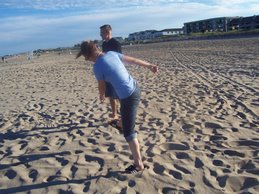It's no secret to most people who know me that I really really love museums. A lot. In fact, the highlight of my trips around Europe were frequently museums (or cathedrals or ruins, but the basic idea is the same). On the other hand, there are plenty of people (kids and adults) who start yawning at the very mention of visiting a historical site or (God forbid) actual museum.
I'm not including science museums in this generalization. Science museums have this added bonus of being very visual, very hands-on, and that attracts all sorts of people. The challenge facing art and history museums and sites is entertaining someone with something that isn't inherently dynamic.
My internship in London was at a site that used both its historical prowess (it was built in 1775) and its innovativeness (add an ice rink to digital exhibitions and what do you get?) to create what I feel is something much more than a gallery or museum. Visiting was much more of an experience, much more active than simply viewing or reading.
It's plainly obvious that museum attendance will suffer with the advent of Wikipedia and other online resources. Why would you need a museum when the information is at your fingertips? The answer to that question comes with changing the very foundation of what museums appear to be. They are not merely collections of objects - they are places that have an opportunity to tell an audience the story of the past, the lessons learned, the hows, whos, and whys of what made us... us.
Museums have to step up into the multimedia age and deliver an experience, but they can't forget why they are so unique - the access they have to these stories and their related artifacts is unmatched by any Wikipedia article.
I promise this blog isn't going to be all about my thoughts on museums and public history - but it is good food for thought!
Tuesday, June 12, 2007
Subscribe to:
Post Comments (Atom)


No comments:
Post a Comment